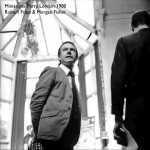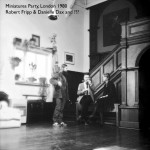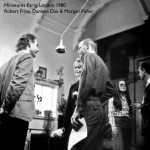M1-24 Robert Fripp
“Fripp!!!” (which is how Robert has been known to answer the telephone) stands out in the music world as an utterly unique player and thinker – that much was obvious right from the opening riff of the first album by King Crimson. That album – a fucking stunning debut – exploded out of nowhere in 1969 (well actually, out of the rather twee efforts of Giles, Giles and Fripp) and contained some of the most violent, and serene, music I’d ever heard. Currently, Robert documents his daily life and career in meticulous (one could say interminable – I think he is doing it for his own discipline, but who really wants to read all that?) detail at DGM Live. Writer Eric Tamm has also written extensively about him for all to read online. I think for this blog, I will simply list the instances I can remember where I met him or was affected by him and his work.
First KC live show I saw: Marquee Club, summer of 1969, when they were playing there every week. The famed Marquee in London’s Wardour Street was actually a modest-sized club, dark, dank, hot and sweaty, but seeing KC perform, with a few rudimentary lighting gimmicks (simulated flames, and a strobe) and Ian McDonald ecstatically playing his Mellotron, transformed it into a vast temple of music which left me utterly gobsmacked. Prog rock beckoned to me – but not the prog of difficult time-signatures and cosmic lyrics – the prog of symphonic glory, of divine inspiration – but not pompous. There was always that edge to KC (they inspired the likes of Public Image Ltd.), and some ethereally beautiful moments too. The lyrics got a bit airy-fairy on occasion – sometimes I thought Fripp doesn’t give a fig for the lyrics, as long as there’s someone around to do the job. That someone, Pete Sinfield, eventually had to leave the KC fold, and went on to write for Celine Dion, Cliff Richard and Bucks Fizz. Life’s funny that way.
They were playing football in a car park behind a London theatre where they were to play that evening, the next time I saw KC. Naively I thought this was out of character for prog-rockers of great virtuosity. It was 1971, and they were into their second line-up, so among the rowdy, laughing soccer players was their bassist/singer Boz Burrell. I would meet Boz about 3 years later under vastly different (and for him, vastly preferable) circumstances, when he formed Bad Company with my then flatmate and (soon to be ex-Mott the Hoople) bandmate Mick Ralphs. Boz didn’t really get on with KC’s world of music (“Fripp can’t even play a blues – no soul” he once complained to me) – but on the other hand, Fripp had taught Boz to play bass almost overnight; he had joined KC mainly as a singer when suddenly the the bass chair also became vacant.
But back to the car park: I was coming to the end of my first band, the pop/soul Love Affair, and prog was beckoning to me temptingly. Love Affair’s manager Sid Bacon, a kind man but very conventional looking – shiny blue business suit (“got it made in 24 hours in Hong Kong!”), tie, plump, bald – was with me, and embarrassed me slightly by managing to collar Fripp in the car park and introduce me to him, telling him of my plans to form a prog band. Robert, I remember, smiled a lot and seemed to show great interest. It eventually lead to my auditioning Ian McDonald, who soon left KC – but that didn’t work out. Finally I put together my band and within a year we had released our first album.
Arthur Brown was the opening act, with his Crazy World Of band, next time I saw KC, in some northern university (still the Mark II version of the band). It was delightful talking to wild man Arthur (off stage, a charming and mild man) in the dressing room, chatting about mundane matters and drinking cups of tea, even while he was still dressed as half-man-half-woman with his hair worn long and a wedding dress on one side, and half a beard and half a tuxedo on the other. Dedication! One thing that was new about KC at this gig was that occasionally they ran Boz’s voice through a VCS3 synthesizer’s ring modulator, making it sound robotic, as on their Beatles-breakup song “Happy Family.”
Fripp’s big break preceded my next viewing of him. After forming the more improvisatory KC Mark III he folded the band and went on a three-year sabbatical, immersing himself in the spiritual work of J.G. Bennett and others. Fripp prefers not to discuss this period in public, so I will respect his privacy and not dwell on it it further here (the Eric Tamm link at the beginning of this blog goes into some detail). Certainly a haircut was involved.
The League of Gentlemen, live, May, 1980 at the Marquee. Fripp was touring with his “second-division touring new wave instrumental dance band.” Oddly named, considering their bassist was a gentlewoman. It was there that I invited Fripp to do his miniature. He immediately offered to send a tape of Queen Elizabeth’s voice, saying that when slowed down it sounded exactly like Prince Philip. In the end what came through the post was the above primitive exercise in polyrhythms (on organ, not guitar), which I believe may have been in preparation for the new music he was about to unleash on the world with the 1981 “Discipline” album. From here on, Fripp was into mathematical, precise rhythms and polyrhythms, which impressed me hugely at first but have gradually lost their appeal for me as the years have rolled by (in the same way as Steve Reich and Philip Glass).
Some say that he invented Frippertronics – a technique of using tape recorders to create long delays, echoes and loops, allowing a single player to build up thick layers of sound, live on stage. In fact, the system had evolved from experiments by electronic music composers in the 60’s – especially Stockhausen, who created a complex version of it for his piece “Solo” (1966). Anyway, Fripp streamlined the system for on-the-road use, and I saw him Frippertronning at the ICA in London in 1980 (strangely, this concert is not listed in his very meticulous list of tour dates). Fripp was generous in praising the Miniatures project to his numerous friends who had gathered – a bright, sophisticated group of people who I guessed may also have been involved in the J.G. Bennett work.
Danielle Dax, the sexy punkish diva was on Fripp’s arm the next time we met in 1980. It was in a black-hole-style club under the Westway in London. I was there to see a concert by Metabolist and decide if I should invite them to participate in Miniatures. I did, with pleasure, on hearing their angular distorted motorik sounds.
We met for the 4th time that year, at the Miniatures release party at a friend’s huge sculpture studio in London. Danielle was there, many of the Miniatures artists came, and a great time was had by all, with comedy and puppet shows, afternoon tea and homemade ginger cake. Three photos follow:
In 1985 Fripp, out of the blue, wrote me a letter saying how delighted he was to have just been asked to run the American Society for Continuous Education at Claymont Court in West Virginia, where J.G. Bennett had established his school shortly before he died. I was surprised by this and didn’t really know how to answer, so I filed it away. Perhaps it was a subtle invitation to join him at the school, or at least get involved in that line of study (which would eventually lead to his Guitar Craft workshops). I had already an interest in Bennett and Gurdjieff (I particularly loved the Gurdjieff music and included an example of it on Miniatures 2). However, I was not ready to commit to any extended period of study, and instead read various books and did research at my own pace.
Huntington Beach, California, October 1990. I had literally just got off a plane from Tokyo to LAX, rented a car, and drove speedily down Pacific Coast Highway just in time to make the show, in a surprisingly small club, almost a disco. This time it was Fripp plus the League of Crafty Guitarists – about nine players who had been studying with him. All played acoustic guitars (possibly all the same model, probably using Fripp’s New Standard Tuning: CGDAEG, which can be remembered by the phrase “California Guitarists Drop Acid Every Gig”). It was brittle, occasionally lyrical, sometimes even amusing, as when Fripp instigated a human echo machine, where he would play a short phrase and in strict tempo a second or so later it would be repeated by each guitarist in turn. (Mantovani apparently used a similar technique to achieve his “Cathedral Effect” in the days before echo boxes – an effect that transfixed me every time I heard it in the intervals between films at the local fleapit in the 50’s). The last words I said to Fripp that night were, “your hard work seems to have softened your face.” He smiled, like a friendly vicar.
Tokyo, with David Sylvian, was our next contact, in October 1993. Fripp had played on Sylvian’s “Gone to Earth” album (which featured a brief sample of J.G. Bennett’s voice) and was now on tour with him. I hadn’t seen Fripp in a band since 1980 and amplification had improved/increased so much since then that the sound of Pat Mastelotto’s bass drum hammered hard on my rib cage throughout most of the show. I mentioned to Fripp afterwards that I had moved towards the back of the hall to try and lessen the impact, without much success, and that what finally lessened it – turned it into a blessing in fact – was when I was able to take it to heart, i.e., change my mental attitude towards it and accept it as a sonic gift of sound and not as an attack. Fripp seemed to approve of my comment. In fact I had always felt that even with his (and KC’s) loudest songs, there was never the harsh, brutal quality of say Metallica or AC/DC, just as there never is with thunder.
The last time we met, in August 1994, Sylvian and Fripp returned to Tokyo to create “Redemption – Approaching Silence,” an installation in a zen Temple organised by a remarkable arts company called P3. It was dark and rather hellish, with skulls. This time Fripp took care of the words, Sylvian the music. Sylvian’s wife, Paisley Park singer Ingrid Chavez was there, with their adorable coffee-coloured baby. Around the happy trio a strangely out of place domestic bliss reigned. I supped the free wine, and searched for a can of Japanese tea for Fripp. (sidenote: earlier this year P3 curated my light paintings for a show in Yokohama.)
Fripp had already made his track for Miniatures 2 in 1994, quick on the draw as he was only the second artist to contribute to that project. This time I was very pleased that he played guitar, and extremely powerfully too, together with bass virtuoso Trey Gunn. Due to the international complexities involved in creating this second volume (vastly more than the take-a-Revox-to-their-house approach of Miniatures 1) the album was not released until 2000.
Years later, in 2006, Robyn Hitchcock was performing in Tokyo and invited me to play with his band which included Peter Buck from REM and their additional guitarist Scott McCaughey and drummer Bill Rieflin. Bill mentioned that he had an ongoing ambient improv project with Fripp called “Slow Music” – a nice coincidence in that I had, in 1980, made an album with Lol Coxhill which had the same title. So, at second hand, that was my last fleeting connection with this inimitably pioneering musician, Mr. Robert Fripp of Wimborne Minster, Dorset.
To end, an off-the-cuff handful of my favourite Fripp musical moments:
CAT FOOD – the best ever combination of a rock band with a free jazz musician – the extraordinary Keith Tippett on piano.
PRINCE RUPERT AWAKES – well prog, well Tolkien, but some serious edgy discords and tasty reverse guitar. Guest vocal by Jon Anderson. And a nice cheerful minor/major tune. Sorry about the visuals by Roger Dean…
DARYL HALL: WITHOUT TEARS – Fripp, now KC-less in 1977, finally gets to work with a real singer. Hall had just quit Oates and made this for his debut solo album. “Not commercial enough” said RCA, and didn’t release it for three years.
BOWIE: SCARY MONSTERS (AND SUPER CREEPS) – powerful Cockney comeback by DB with Fripp nailing it mostly in the first take for the whole album. Bastard!
A BLESSING OF TEARS – Frippertronics evolved to symphonic dimensions in this heartfelt tribute from Fripp to his mother who had just passed away in 1993.
A scary teacher, a brother in adventure, a muse, a comedian, a stern taskmaster, a man who loves his mum – all this and more I continue to feel about Robert. I thank him from my heart.
Next up: a nanohistory of r’n’r.






Brilliant, funny and engaging piece about an amazing man and one of my all-time fave guitarists, Robert Fripp, he of the small, mobile, intelligent haircut. I always loved King Crimson, right from the first monster riff off the first album, ‘In The Court Of The Crimson King’, through the present day. My fave incarnation was the ‘Larks’ Tongues In Aspic’/’Red’ era. I must have seen them at least a dozen times, and Fripp was always creative, on the edge, and focused. I met him only once, at a Sound Warehouse record store in Chicago in 1979. Bob was giving a demonstration/performance of ‘Frippertronics’ with the dual Revox tape recorders. After the show, I introduced myself, and he was quite charming and witty. He signed his solo album, ‘Exposure’ with a comic word balloon above his face: ‘Hi Connie!, Robert Fripp’
He remains a powerful force and inspiration to me, and to many others. Worrabloke, Robert Fripp!